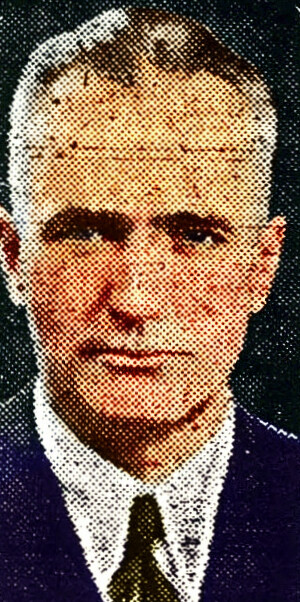McNutt eases restaurants’ midnight rule
Those serving war workers exempt
…
Evelyn Chandler back with new thrill – stars, costumes brilliant in best edition
By Dick Fortune
…
Delivery setup still complicated
…
Walworth Company plant walkout continued
…
Mother calls it ‘the most horrible, inhuman, brutal act in the world’
…

By Maj. Al Williams
Iwo Jima is an island a little more than four miles long, two miles wide at its widest point, and roughly the shape of South America. Its terrain is generally sand dunes, with no elevation over 554 feet.
American naval task forces swamped the Jap airpower on Iwo in a matter of hours. Complete dominance of the air over this fiercely contested patch of sand was ours. Yet our Marine losses have been far out of proportion to those of any previous engagement, and Marine Gen. Holland Smith says this struggle is the fiercest and toughest in the history of the Corps.
American naval task forces carriers, battleships, cruisers, destroyers and supply vessels are free to steam all around this tiny island without interference from the enemy. Yet the hand-to-hand fight continues and the cleanup job is still being done by infantrymen (Marines), aided and covered by air and naval forces as occasions permit and indicate.
The word “why” grows bigger day by day. Why must such a grim job be done by ground forces? Is it not apparent that this Iwo Jima situation shows a gap in either the machinery or tactics, or both, of modern warfare?
Isn’t there some other way to completely reduce an enemy position of such diminutive size other than men running forward, crouching, firing small arms, ducking into holes in the ground, hurling grenades, and using all the ground weapons of ground warfare?
As the score stands, this bloody fight on Iwo Jima mistakenly may be interpreted as a direct challenge to airpower. Haven’t we any new tricks? No “firsts” for us, instead of imitations of strategy and tactics invented by others? Does it definitely mark a critical limitation of airpower? Isn’t this just the sort of spot airpower should be able to render completely uninhabitable?
Of course, we don’t know all that actually is being done. But in the wake of the news that we have lost between 5,000 and 6,000 gallant Marines comes the question, “Can’t we find any other way – and where is airpower?”
Two miles by four miles – an island. The enemy force is composed of land forces only, and no adequate cover. Are we using all the available carrier planes for the continuous bombing of this sand spit? Have we dozens of barges or scows laden with trench mortars and small howitzers sending rolling barrages across these sand dunes?
If bombs and machine gun fire can’t do the trick, isn’t there any other expedient – any other than having our boys march and crawl to finish each Jap after the century-old fashion of pikemen?
What about gasoline and phosphorous combinations? Materials mean nothing to us. Lives mean everything.
Surely there must be ingenious American minds that can find some way to drench that dirty little sand island with some kind of inflammable liquid dropped from the air and burn the thing to a crisp.
As the Iwo Jima score stands today, it is a square challenge to airpower – or to the ingenuity of those who possess it.
Troops forced to experiment and improvise – German lines are invaded for materials
By Tom Wolf
…
Brainy college girl planning both learns by experience
By Ruth Millett
…
Padded hipline also shown
By Judy Barden, North American Newspaper Alliance
…